Brighton & Hove Albion are the talk of the town of late. Roberto De Zerbi’s brand of football, as well as the club’s overall model, are taking the stage by storm and doing it rather efficiently. From intriguing tactical principles to off-pitch transfer policies, the Seagulls are truly an excellent subject for analysis. All of that makes them not only exciting to watch and dissect, but also means they offer the perfect environment for young talents to develop.
Our recent scout report looked at Levi Colwill, Chelsea’s loanee who will presently be flying back to the blue side of London, leaving Brighton without a marquee project player. But knowing the Seagulls, they will surely soon have someone in the pipeline ready to take the young centre-back’s spot.
So in this tactical analysis, we’ll make a recruitment suggestion to Brighton, arguing the Premier League side should look into Liverpool’s academy and snatch up Zach Awe while he’s still flying under the radar.
The analysis will look at how he fits De Zerbi’s tactics and business model while also considering his traits and suitability for the club.
Brighton’s transfer policy
By now, everyone is familiar with how Brighton & Hove Albion do their business so not much analysis is needed on their transfer policy or tactics. However, to fully understand the parameters of our search, we need to outline the most important aspects of both, starting with the transfer policy.
David Weir, their technical director, probably explained it best while talking to My Albion TV last summer: ‘Every player has got a plan. As we know, football changes every day. So that plan can also change every day. It is a particular part of our model and how we work. We are probably not a club at the minute that is going to buy Premier League-ready players who are going to be top 10 Premier League footballers, which is what we want to be as a football club,’ he said. ‘I think our model is more maybe buying a little bit early and developing those players and sometimes loans are the best way of doing that.’
Identifying, acquiring, developing and then selling on big talents is what Brighton do best and have done for years now. We needn’t look further than the sales of the likes of Marc Cucurella, Ben White, Yves Bissouma or the ones bound to happen eventually in the form of Moises Caicedo, Alexis Mac Allister or Kaoru Mitoma. All of these players have been brought in cheap but are now worth a small fortune compared to their initial fees.
The most important thing to understand here is that this isn’t pure luck; an abundance of their transfers don’t end up in profit, yes, but they all follow a similar blueprint. Brighton & Hove Albion buy high-potential youngsters and develop them until they’re ready for the next step. Sometimes they have to cut their losses but the big sales generally cover up the losses and then some. In fact, since the winter of 18/19 which roughly coincided with the appointment of Dan Ashworth, now at Newcastle, until the present day, the Seagulls have recorded a net spend of just €48.97m.
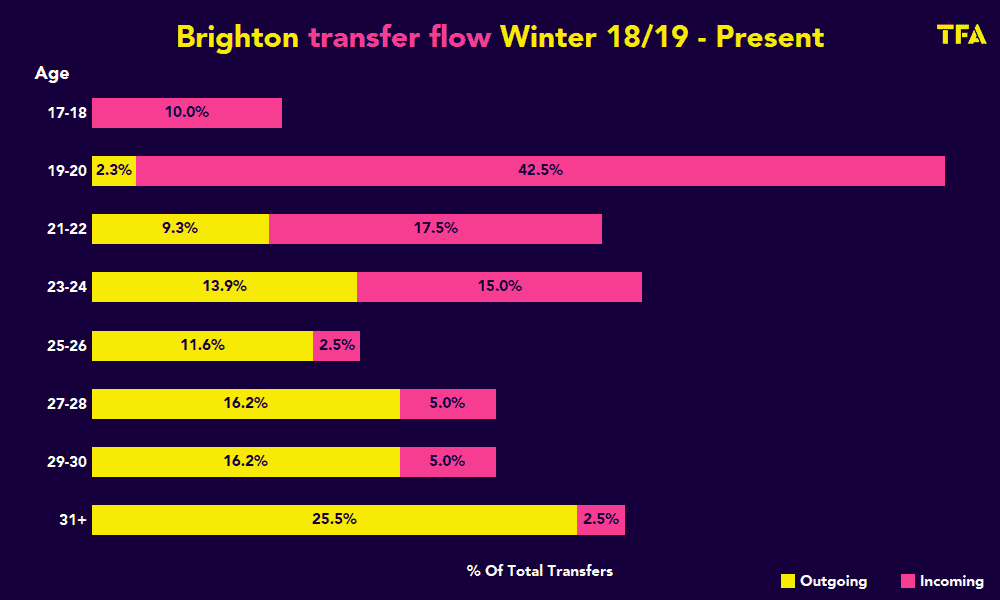
And looking at their transfer flow in that period, we can see how they’ve made that possible in the first place. The recruitment strategy is firmly in place. Buy young and cheap, develop and then sell for massive profit. That’s the blueprint. And they’re following it almost religiously. The graph we can see here confirms this.
Between the winter of 2018/19 and now, Brighton have bought or loaned a total of 40 players. Of those 40, 10% were players between 17 and 18, 42.5% were between 19 and 20, 17.5% were between 21 and 22 and 15% were between ages 23 and 24. There’s a trend we need to highlight here. As the age increases over 20, the incoming transfers start dropping off immensely. In fact, in the last five years or so, Brighton have practically not signed any players over the age of 24. To be more precise, there have been only six players aged 25+ that were brought in in that period, mostly for largely insignificant fees.
It’s also worth noting that this applies to almost all positions across the pitch. In that period, Brighton have brought in a total of 11 defenders, spending €6.51m on average with the average age of those players at only 21.45. Interestingly, though, the newcomers seem to be the oldest in the defensive line, signalling this is the area where Brighton may go for more experienced personnel. But players like Cucurella or Pervis Estupiñán, aged 23 and 24 at the time of transfer respectively, raise the average age by quite a bit.
Generally, however, every position will have an abundance of youth with an occasional more experienced player sprinkled in to solidify the foundations. The same happens with the midfield line where they brought in a total of 15 players with an average age of 20.46 and the forward line with 12 players with an average of 21.58.
Quite clearly, if they are investing, they will invest in youth and potential over anything else.
Tactical model
The other metric crucial to Brighton & Hove Albion’s recruitment process is the game model. The Seagulls are a club with a very well-defined setup and De Zerbi’s tactics require a certain profile of players to be able to work well. Since we are looking at replacing Colwill, we’ll focus on the backline and will need a player who can replicate his contribution while still fitting the overall philosophy of the club.
In-possession principles are very important here because Brighton are very particular in how they like to operate on the ball. Defenders need to be able to defend well, of course, but if they don’t have the required on-the-ball characteristics, the whole system will suffer. Looking at their passing and touch map, we can immediately see the importance of the backline in possession of the ball.
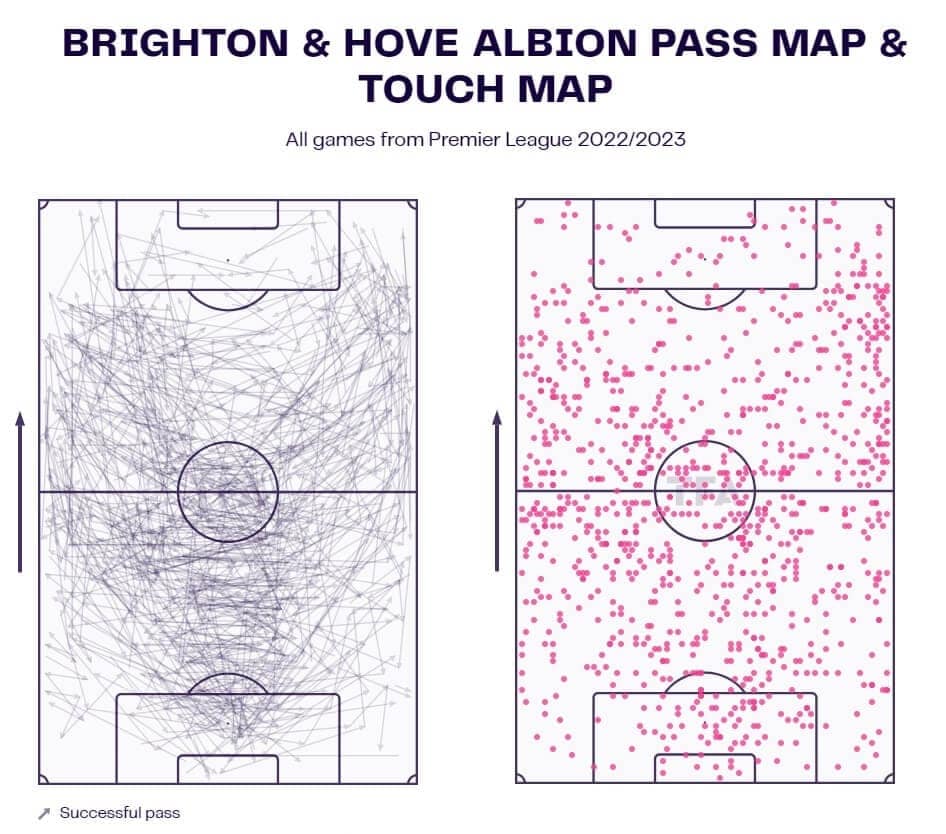
Brighton are a possession-heavy side and as such, a large portion of their activity comes in the first and middle thirds of the pitch. The centre-backs are key in not only recycling the ball but also attracting pressure and accessing crucial targets further up the pitch. In fact, as the pass map shows, square passes between the defenders in a horizontal manner are encouraged in De Zerbi’s tactics.
As the defensive line sets up relatively high on the pitch, being strong and secure on the ball, as well as showing composure and maturity, is important for their centre-back profiles. They are the lynchpin of the team that sets everything in motion. They have to be tactically aware, technically sound and well-coordinated to be able to execute the various build-up principles their coach has envisioned. Along those same lines, their composure in baiting the press and bypassing it is equally important.
Another aspect they have to be strong in is progression, either via passing, carrying or both. Our next visual shows us Brighton’s progressive passes and runs across all Premier League games in 2022/23.
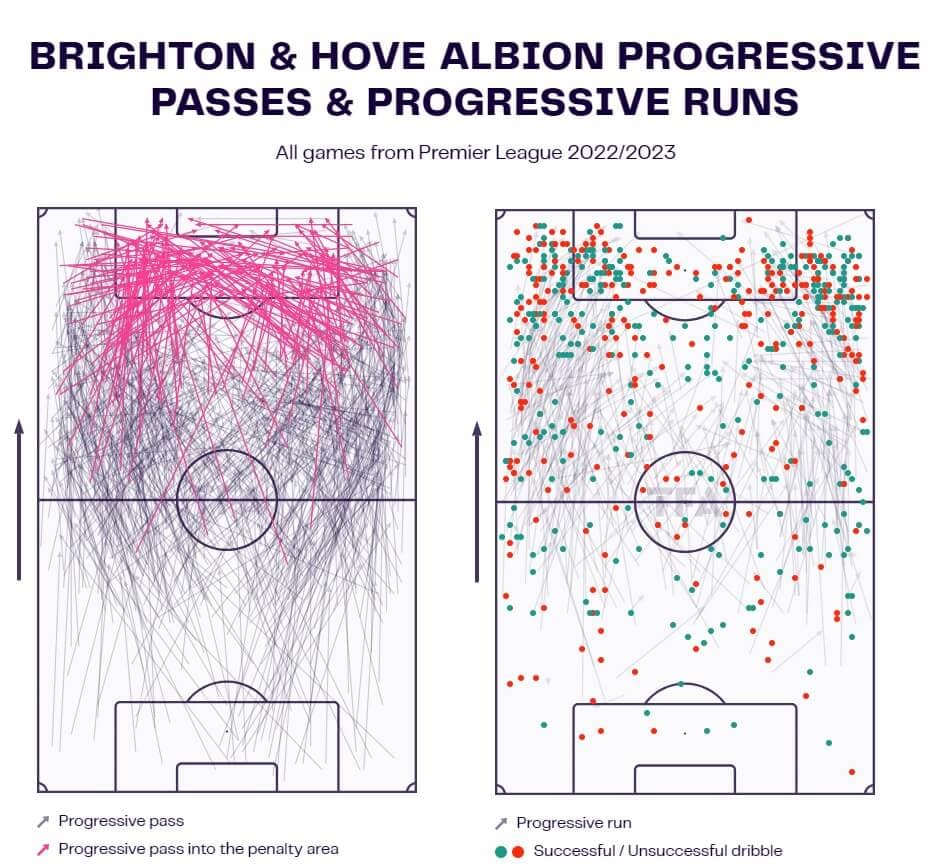
While there’s high activity in the opposition’s half-spaces, many progressive actions stem from deeper areas of the pitch, often even from the backline itself. This is a very important trait for their defenders in general but also for a player who’d have to replace Colwill on paper. The young Chelsea loanee is a left-footed centre-back with carrying and passing proficiency, especially from that left half-space which opens many angles for Brighton’s progression. More on that later on in the analysis.
All of that screams for a ball-playing high-line centre-back who can not only facilitate play but also switch between an aggressor and balancer. In other words, Brighton could use a defender who will provide them with the offensive impetus while also being calm and collected in possession when needs be.
In fact, just by looking at their current roster of centre-backs, we can see a clear pattern emerging.
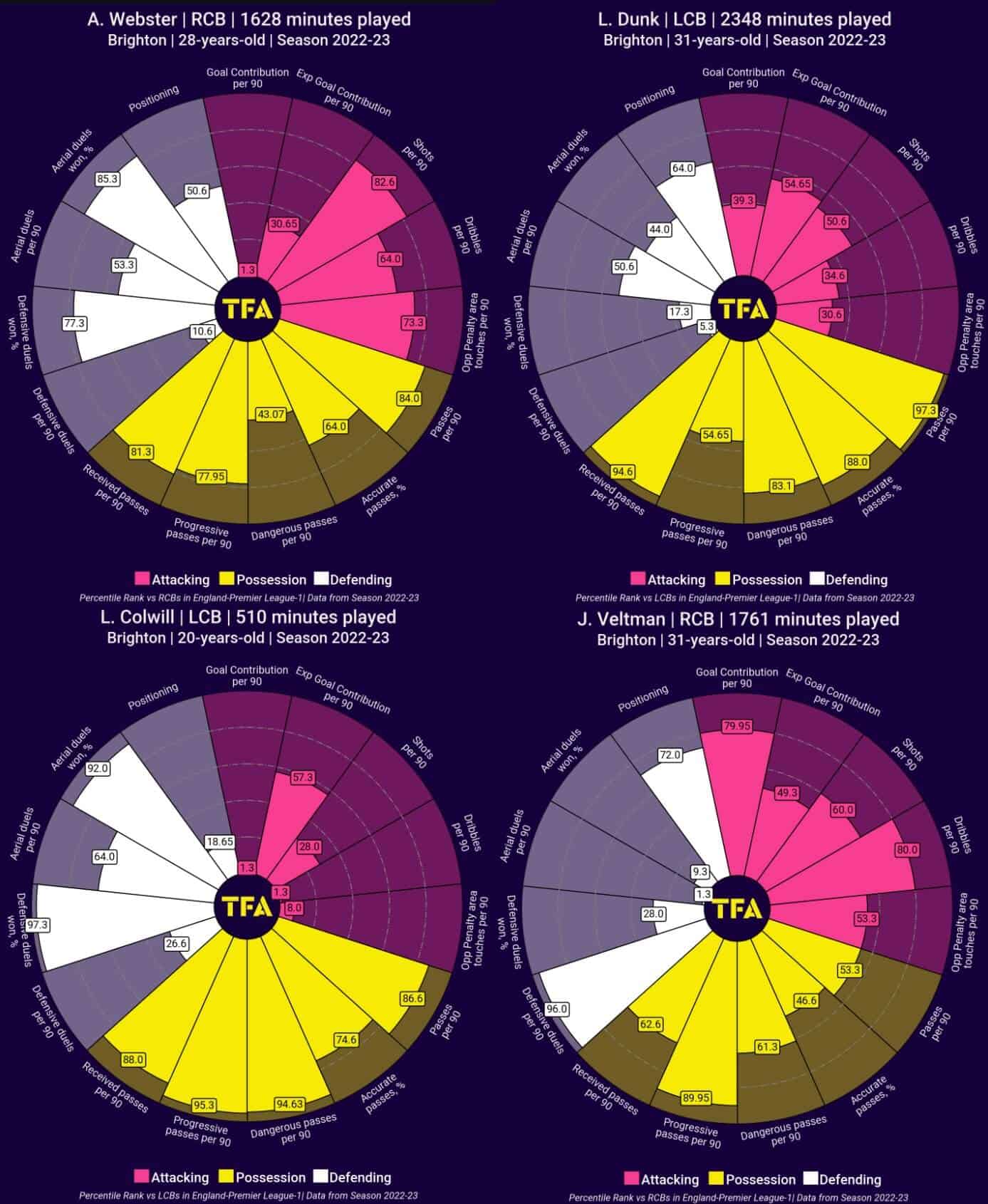
While Brighton & Hove Albion have an enviably diverse cast in the backline, there is a clear preference for certain traits all of these players possess: on-the-ball quality. Just by looking at the pizza charts, we can see all of their defenders excel in possession. This is true for all of them but especially for Colwill, the player we’re trying to replace. So naturally, considering the whole setup and the profile of the centre-backs, we can slowly paint a picture of the player we’d need.
It has to be a young player flying under the radar, preferably aged between 19 and 20, with low market value, a defender with a well-balanced profile but with clear proficiency on the ball and with the ability and comfort to play as the left centre-back in a possession-heavy side. Now that we have the metrics, let’s introduce the candidate we want Brighton & Hove Albion to consider.
Zach Awe player profile
Zach Awe is a 19-year-old defender currently playing for Arsenal’s U21 team in Premier League 2. Standing at 1.92 m, the young centre-back has a tall and slender body, long limbs and impressive physical attributes. Despite feeling lanky in stature, he uses his frame well in offensive and defensive situations. As alluded to in the previous section of our tactical analysis, Awe fits the profile Brighton & Hove Albion are usually in the market for.
He’s a young high-potential player who’s yet to garner heavy interest from big European sides, has low market value with minimal exposure to elite football, fits the preferred age group and covers the position we’re aiming to reinforce at the club. Interestingly, considering his versatility, a very sought-after diverse profile and mental capacity, it’s reasonable to assume there is a high chance of potential profit further down the road. The ingredients are all there, they just need to be mixed in properly. So how would he fit in at Brighton?
Being able to play across the backline and with potential to deputise in midfield is an extremely valuable trait. Not to mention it’s essential for a young player who is still moulding his profile. Putting players in uncomfortable or simply unknown situations is a necessary aspect of their development, and this holds true in many aspects of life, not just football. Awe is a player who is not necessarily challenged enough in Premier League 2 so a step up to a club that could confidently give him both the game time and a great environment to progress is a must.
Brighton are such a club. We’ve seen as much earlier in the scout report. They sign based on potential and then develop that potential with a view of sending them out in the world as a much more refined (and profitable) product. But considering De Zerbi’s tactics, they can’t and won’t sign just anybody. Fortunately, Awe fits the profile as his traits mimic that of Colwill in so many areas. Unfortunately, given his lack of senior football, data is difficult to obtain. However, the eye test has yielded exceptional results.
Awe is a player whose maturity, composure and technical quality on the ball extend far beyond his age. One of the main aspects of Brighton’s build-up play is the pausa to invite pressure. Their centre-backs will play square passes or just roll the ball with the sole of their foot to mask their intentions and wait for the opposition to start the press. Once that happens, they will aim to advance through third-man sequences or access the space behind the press via movement and line-breaking. Awe has all of those traits nailed on.
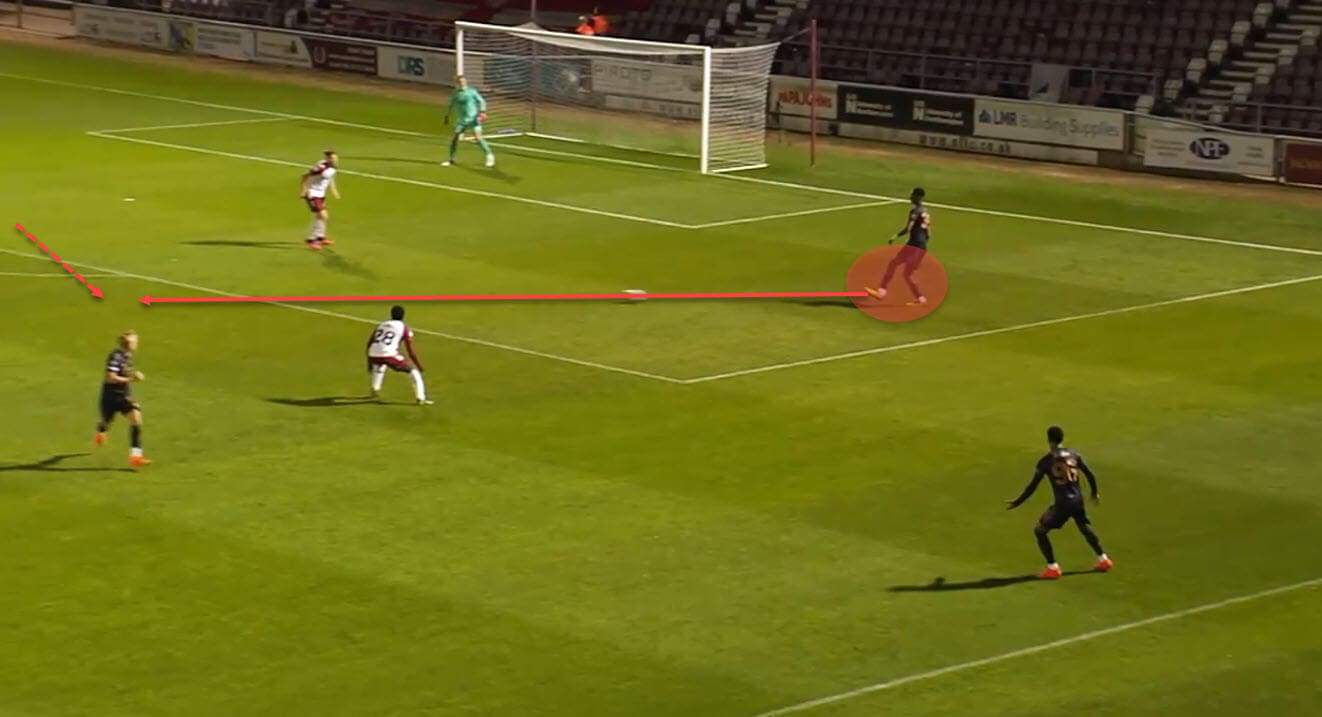
The young defender doesn’t rush into decisions even though he has it in his repertoire to be very protagonistic on the ball. Instead, he will invite pressure until a passing channel is created by his teammates or he’ll manufacture it himself. In the image here, we see him wait on the ball until his teammate moves into position and becomes accessible with a short simple grounded pass. These are generally without much fault; Awe executes short passes with enough power and good posture, almost entirely void of wobbling effects or inaccuracy.
He can progress play and break lines almost with ease but in such instances, he can also be too eager and put too much power into it when trying riskier passes. When it comes to posture and technique, they’re as clean as they get – minimal backlift when connecting with the ball, not leaning back or forward too much, using a minimal number of touches (generally one to two before distributing the ball) and using either foot depending on the situation/necessary angle.
Another incredible trait that fits Brighton’s build-up mechanisms is the manufacturing of passing lanes when there are none. Awe has long legs but is still agile and tidy in possession. In fact, shimmying, feinting, dribbling and carrying are some of his biggest strengths in possession.
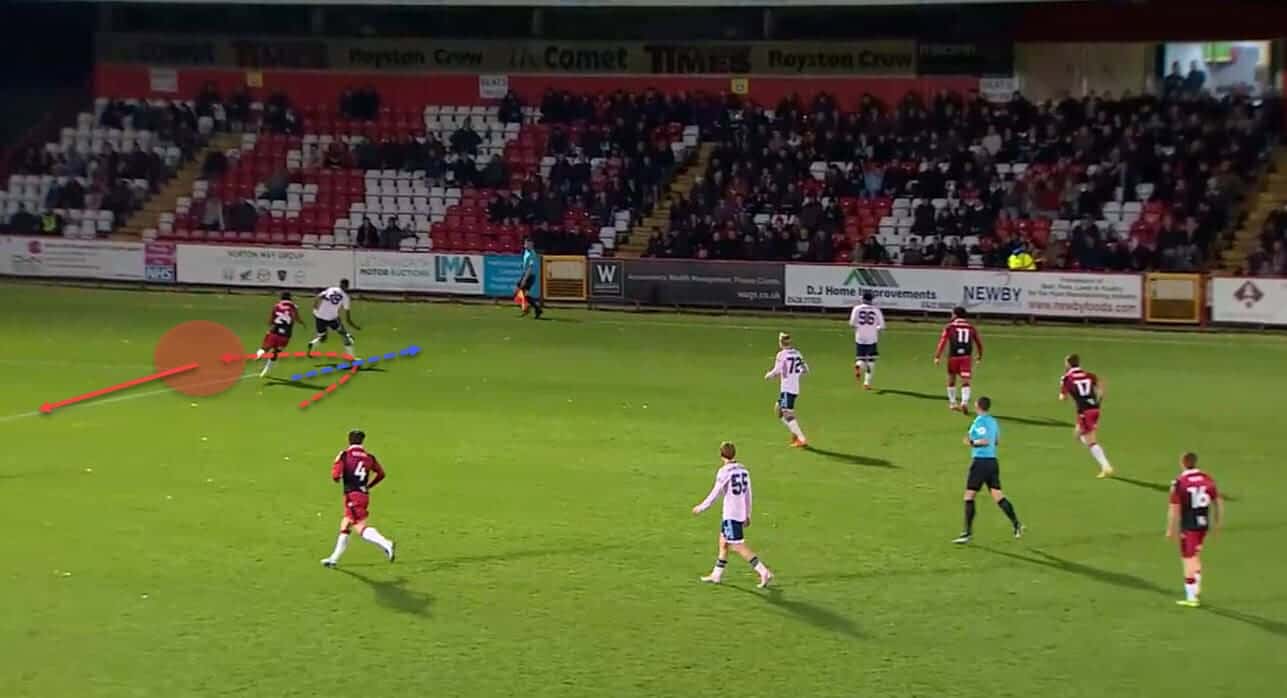
In this sequence, you can see his press resistance in action. Awe’s feints are a valuable asset when attempting to regain control and/or bypass the first line of press. Playing in a possession-heavy side comes with certain challenges and facing immense pressure is among them. Fortunately, his composure, maturity and technical quality shine in such instances. Here, we see him shake off the opponent to stabilise the build-up phase. His control, pass variation and selection make him a good-to-great tempo setter from the backline, which also requires certain proficiency in decision-making, a trait usually best developed through experience.
But experience is the fundamental developmental aspect Brighton offer to young stars in making such as Awe. With the fundamental characteristics already being exceptionally well-founded, his ceiling seems very high. Having the basics such as variation in reception, body orientation, angle support and ambipedal nature on top of it covered is an excellent starter pack, especially given the position(s) he likes to occupy. Two more of his in-possession traits fit Brighton like a glove: weak foot usage and vertical running.
Being a right-footed player with weak foot proficiency makes him a unique asset in world football. Awe is almost as comfortable with his left as he is with his right, which opens different angles in possession across different phases of attack. Playing on the left side of the backline, whether that’s in a CB duo, trident or even playing as a left-back, comes with certain prerequisites. One of them is angled progression and access to priority targets. In Brighton’s build-up, the forwards will often link up with the backline to ultimately access the free players and open space. Awe has the short link-up nailed on but it’s also the long-range distribution that helps in this case.
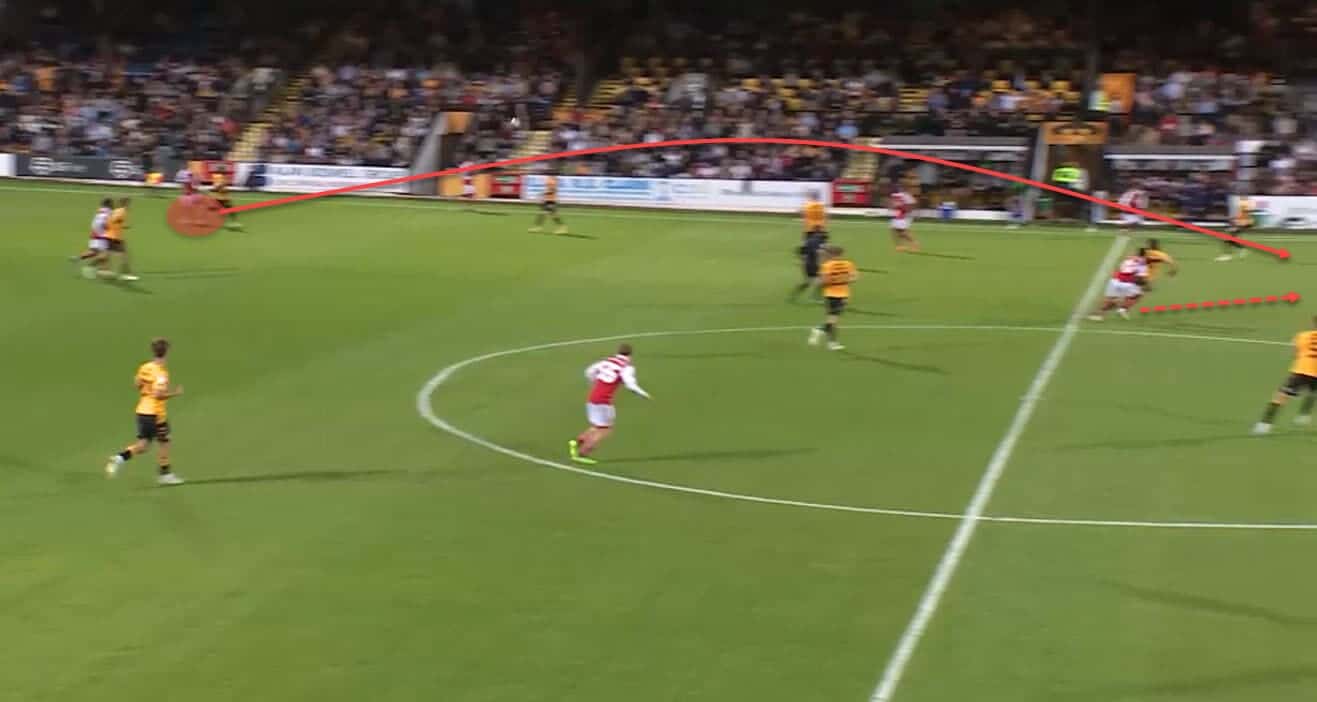
Overall, the long passes are very similar in their base attributes to the short ones: Awe executes them cleanly with enough power, backlift and with enough height. The technique is also generally tidy with his body going across the ball for diagonals and the foot digging under it for appropriate height and placement. That said, the same as short passing, there is scope for improvement in pass selection and the execution that follows it.
Awe will sometimes go long when it’s not necessary or targets easily accessible, which can be a positive attitude trait since he is not afraid to go for more difficult passes but at the same time, it can lead to unnecessary losses of possession. Fortunately, this leads us nicely into the second left channel aspect: vertical carrying.
If he’s not going long and the opportunity arises, Awe isn’t afraid to run with the ball, even beat some markers along the way, and then combine with teammates higher up the pitch. The next image gives us a glimpse of that trait in action.
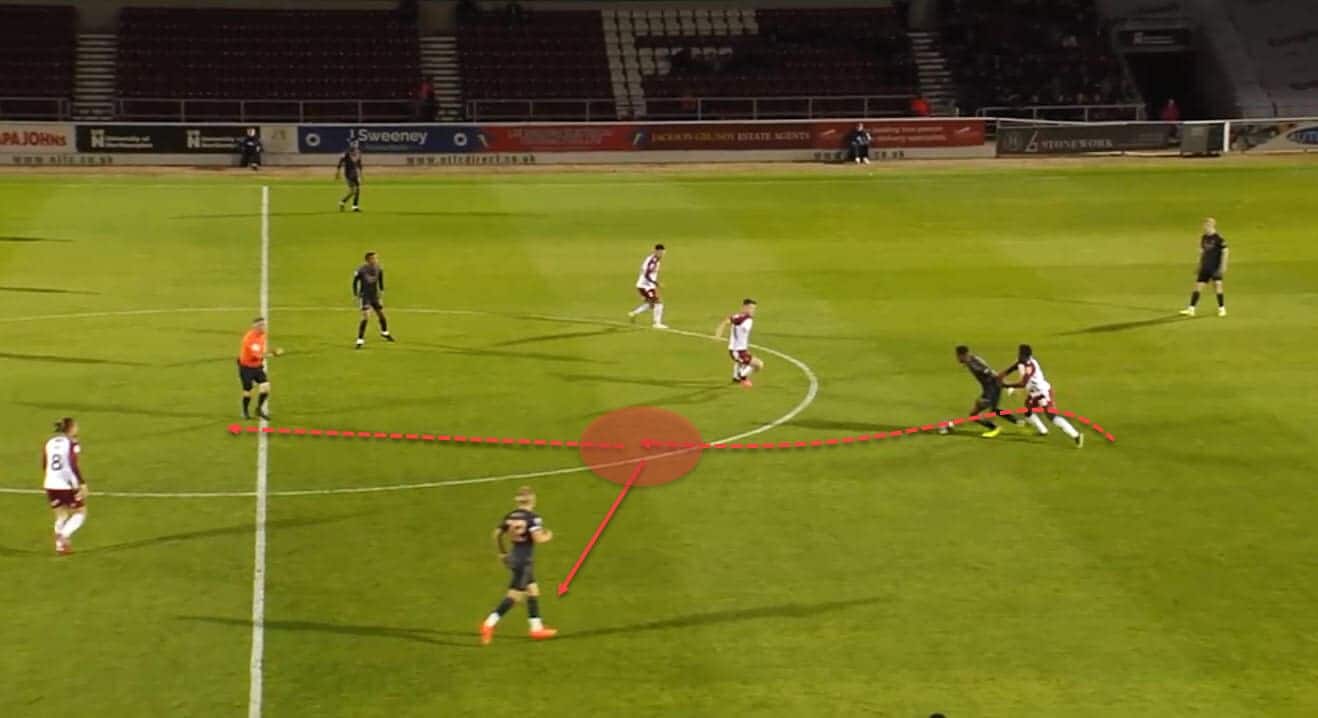
Running is inherently risker than passing but it also comes with bigger rewards. Awe possesses certain gravity when running, attracting markers and forcing them to break their defensive structure. His big strides and good use of frame make him difficult to dispossess and technical proficiency and control also ensure good link-up potential. When we pair that up with a generally offensive mindset and delivery instincts, we get a powerful tool for conquering and exploiting space.
In the sequence here, Awe blitzes past the first line of pressure, lays the ball off and then continues his run. This is important as it represents a big part of his arsenal — Awe isn’t afraid to join the attack from deep and stay there if his presence benefits his team higher up the pitch. This not only shows character but also makes a case for potentially developing him into a more advanced profile, such as a left-back who either overlaps or underlaps. The repositioning and angle support, however, is key across the park, regardless of where it takes place.
The following sequence is very basic but also so telling overall. We find Awe in his half, facing the mid-block press of Arsenal’s opposition.
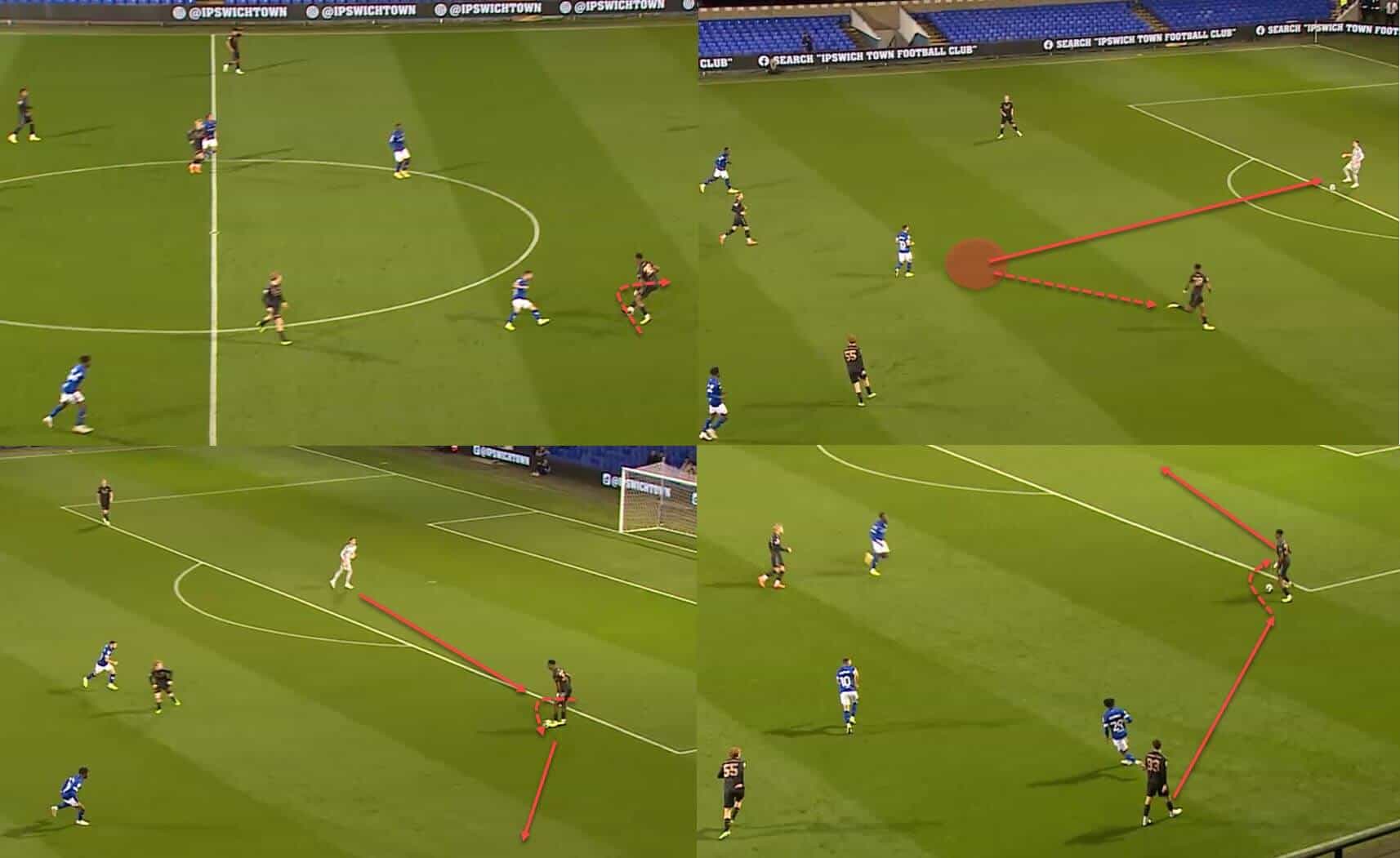
In this one action, we get to see Awe’s composure, recycling, tempo setting, using both feet and repositioning for optimal angle support. Again, it’s a fairly basic sequence but that’s also the beauty in such actions; they are simple and yet ultimately effective. Awe is such a player. A player that can do the flashy things but doesn’t if it’s not optimal is rare. At least for a youngster.
There are more aspects to consider, mainly his off-the-ball tendencies. Being a high-line defender also comes with prerequisites, as is being forced to often defend transitions or win isolated duels. His physical attributes certainly help in recovery speed, outmuscling opponents or winning aerial battles but long legs can be a detriment against low centre-of-gravity dribblers who often turn Awe inside out in isolated scenarios.
Conclusion
Zach Awe is a player who won’t be flying under the radar for long. That means the clock is ticking for teams like Brighton to stay ahead of the curve and snatch him up while everyone else is still unaware. His profile could be moulded into a variety of different roles depending on the preferences and philosophy of his potential new team but just the fact he’s diverse and talented enough to cover so many is huge. At 19 years of age, he’s in the prime years for someone like Brighton to snatch and develop him into a world-beater.
He is not the finished product yet but Brighton are not looking for one anyway. Whatever happens next, one thing is for sure — his time away from the big stage is coming to a close and the time to shine is upon him. Let’s see where his career goes next.

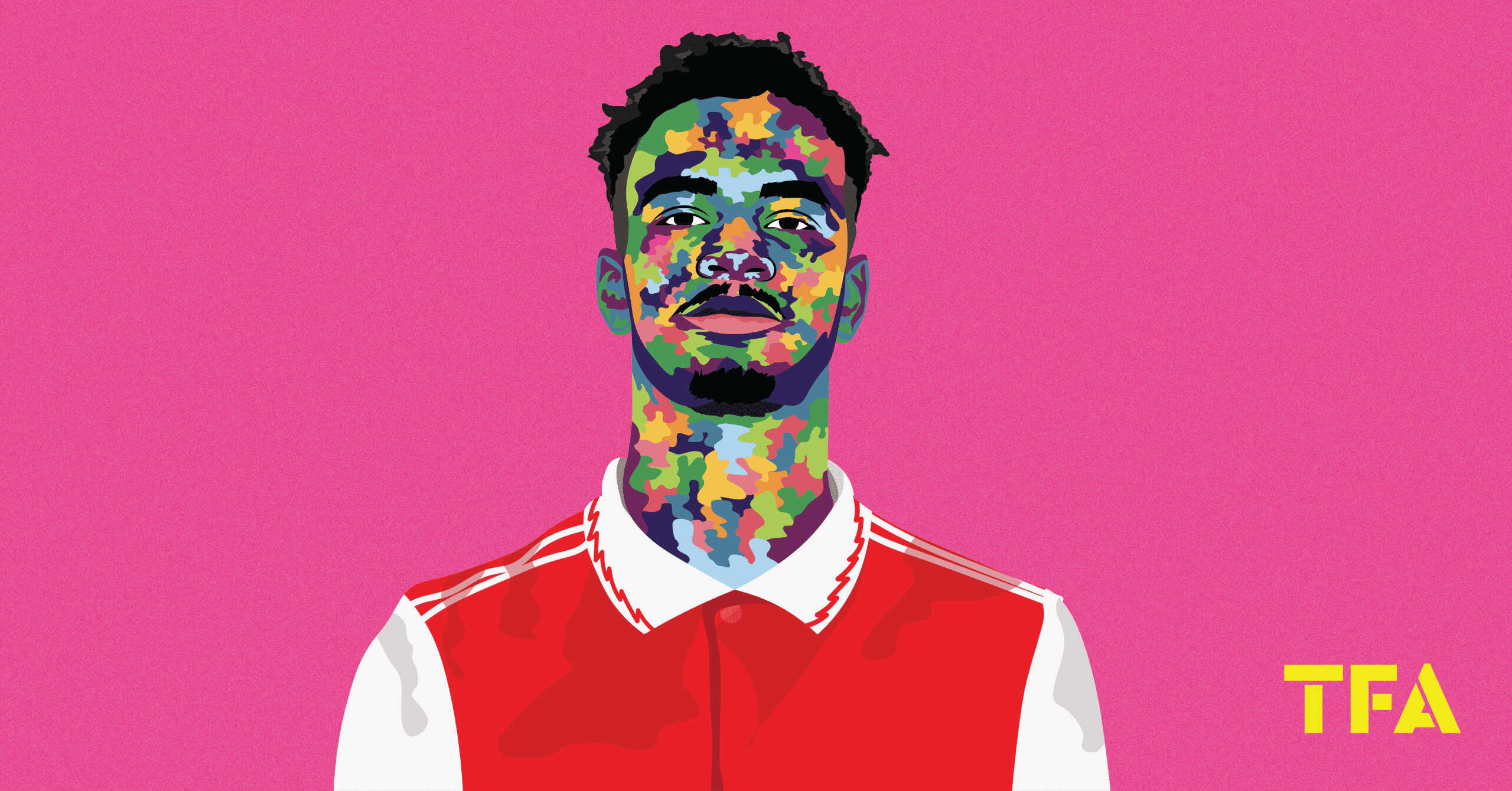




Comments